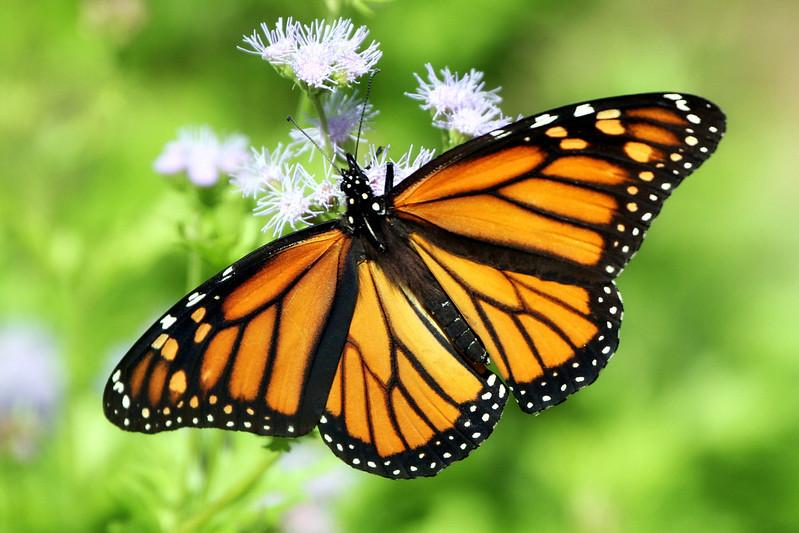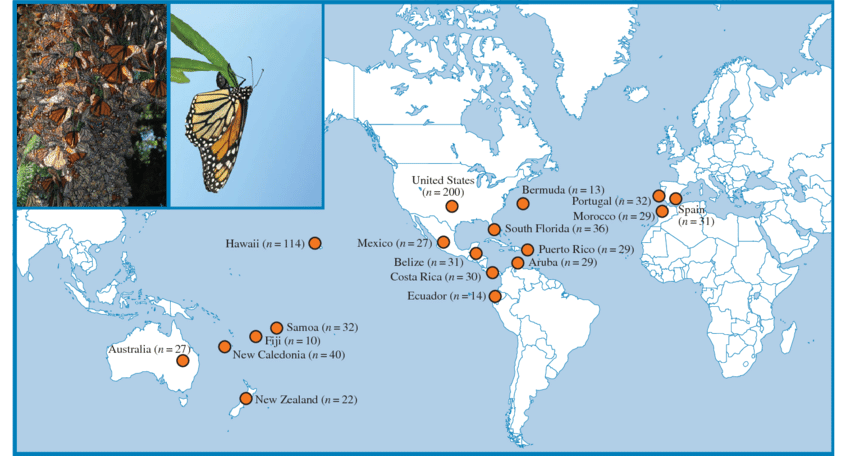Pollinators are any living or nonliving things that help with the pollination process, or the transportation of pollen grains from male plants to female plants. This article will help you learn about monarch butterflies and answer the question: are monarchs pollinators?
Read more: What is Pollination?
Table of Contents
Importance of Monarch Butterflies
Are Monarchs Pollinators?
The monarch butterfly (Danaus plexippus) is one of the most well-known species of butterfly, and is also one of the most well-known pollinators. It can grow to the size of a teacup and have a wingspan of up to 4.1 inches. Monarch butterflies are herbivore insects, which means they solely eat plant and flower products for nutrition. So, the answer to the question of whether monarchs are pollinators is a big yes.

How Do Monarchs Contribute to Pollination?
Fully grown monarchs commonly feed on nectars from different kinds of wildflowers. Due to their diet, monarch butterflies contribute significantly to pollination. They transfer from one flower to another to sip nectars through their sucking tube called a proboscis. This feeding activity enables pollen grains to stick to their bodies and wings and transmit them to other flowers as they feed.
Every year, monarch butterflies migrate from the north to the south of the United States to Mexico. During their migratory period, they rest, eat, and breed in different regions of the continent. As a result of these activities, monarch butterflies contribute to pollination on a vast scale.

Source: Harlen Arschen
Natural Habitat
Monarchs were endemic to North and South America, but since they are migratory insects, they have traveled and spread to warmer regions, including Australia, New Zealand, the Islands of Tahiti and Hawaii, the Caribbean, and even to Western Europe.

Source: Juan Fernandez Haeger
Different locations around the world where monarch butterflies are present.
Source: Juan Fernandez Haeger
They are usually found in open fields, grasslands, roadsides, and meadows where there are milkweeds. This plant is essential for monarch butterflies since they only lay their eggs on milkweed plants. During winter, monarchs usually migrate to high-altitude areas in Central Mexico and the coasts of Southern California.
Lifecycle
Monarch butterflies spend 2-3 weeks laying up to 500 eggs on milkweed plants. Milkweed is necessary for the monarch caterpillar’s diet because it contains toxins that the caterpillars store in their bodies, making them poisonous to predators. Once the caterpillars metamorphosize into butterflies, like any other butterflies, monarch butterflies need to eat every day. They feed on nectar from different wildflowers using their proboscis.
Since monarch butterflies are migratory insects, they migrate to the south each year as the weather becomes colder, leaving their breeding grounds in the northern portion of the United States and Canada, and traveling up to 3000 miles to high altitude locations in Central Mexico where the temperature is warmer. Due to this annual migratory activity, monarch butterflies pollinate wider areas compared to other insect pollinators, like bees.
During their migration, monarch butterflies utilize the sun for navigation. When the sun is covered by clouds, it’s possible that monarch butterflies utilize the earth’s magnetic field through light-sensitive molecules called cryptochromes to keep them on course.
Population Decline
The population of Eastern monarch butterflies, or monarch butterflies that migrate to Mexico, which accounts for 99% of the world’s monarch population, have declined in the past two decades by more than 80%. The population of Western monarch butterflies, or the monarch butterflies that migrate to the coasts of Southern California, has declined in the past 3 decades, from 1.2 million to less than 2,000.

Source: Center for Biological Diversity
This population decline of monarch butterflies is driven by different man-made factors, such as:
- Widespread use of agricultural pesticides that are harmful and deadly to monarchs
- Illegal logging and deforestation of their migration destinations
- Stronger storms caused by climate change that kill them as they migrate
- Habitat fragmentation due to pollution and road construction
Conservation Efforts
Across the United States, different organizations, government agencies, and local communities are working to conserve and increase the population of monarch butterflies. Because monarchs are pollinators, it’s especially important that we work to conserve them, because they provide us with a crucial service.
Here’s an overview of everything you need to know about monarch conservation organizations:
Xerces Society for Invertebrate Conservation
This organization is conducting multiple programs to support monarch butterflies, such as:
- Planting milkweeds and nectar plants that are vital for a monarch’s survival and lifecycle
- Providing rights of way for monarch butterflies by utilizing roadside spaces for planting milkweeds and wildflowers, which can provide miles of monarch habitat
- Creating a habitat restoration program that provides guidance, planning, installation, and maintenance of monarch butterflies’ habitats
Natural Resources Conservation Service of United States Department of Agriculture
- Working with agricultural producers, the NRCS is trying to repopulate monarchs by planting milkweeds and flowering plants.
World Wildlife Organization
- WWF is working with the local government of Mexico to preserve butterfly habitats in the Monarch Butterfly Reserve of Mexico.
- Local communities promote sustainable tourism through appropriate forest management. WWF participates in reforestation in the reserve area by supporting tree nurseries. The monarch butterfly population would benefit from this through the preservation of their habitat.
Read more: Are Deer Pollinators?
